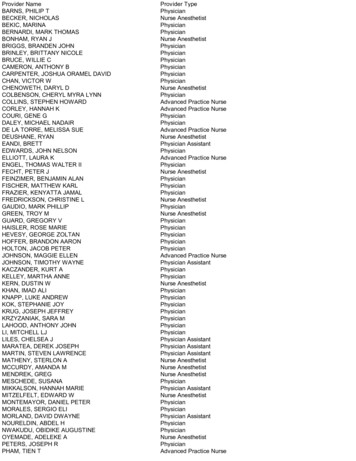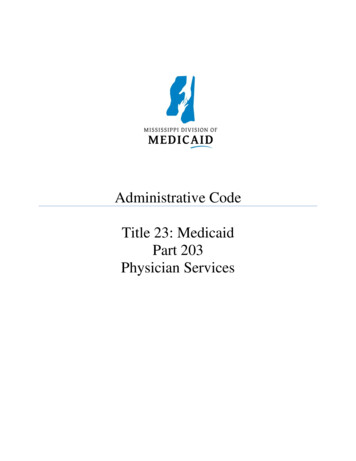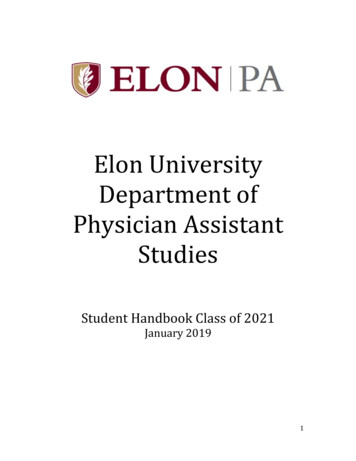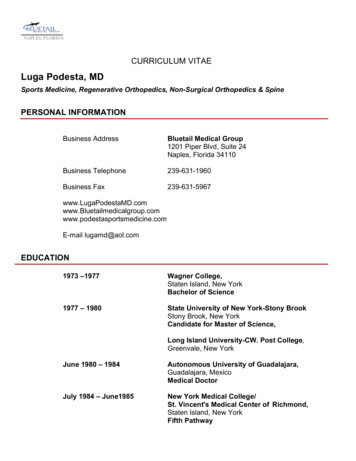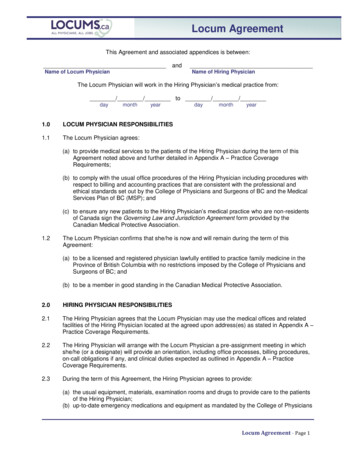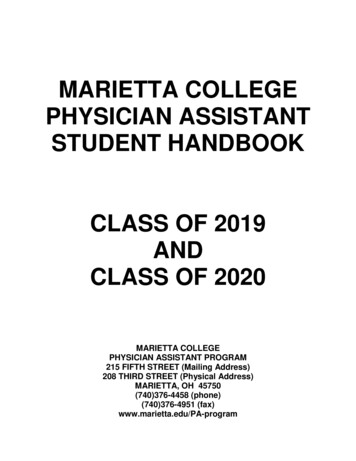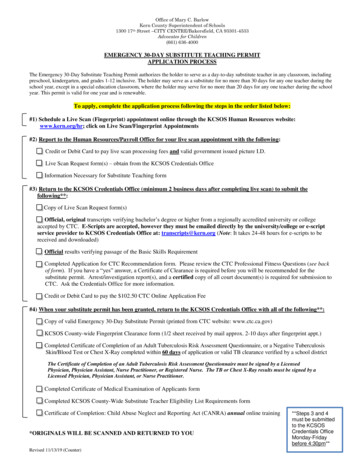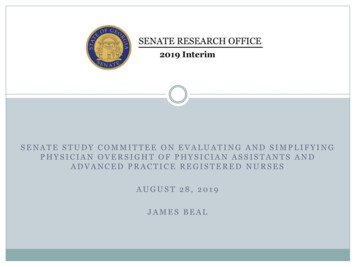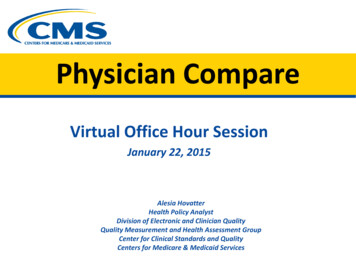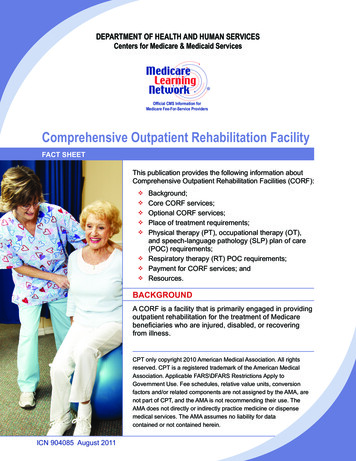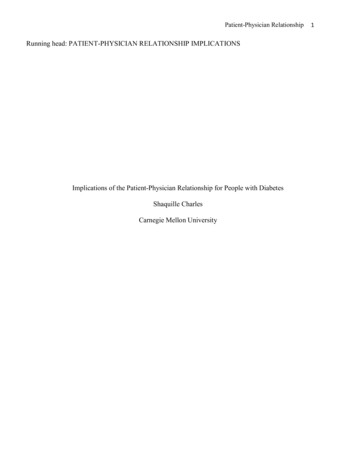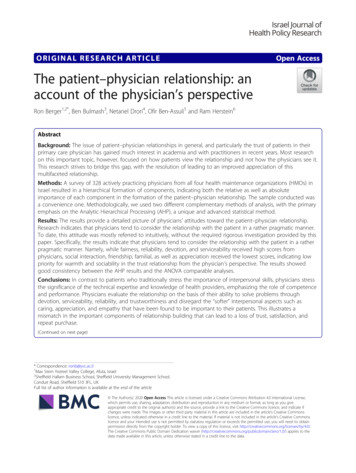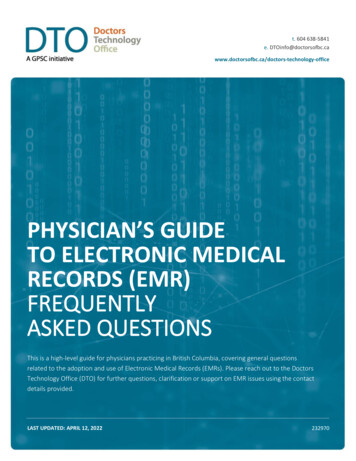
Transcription
t. 604 638-5841e. echnology-officePHYSICIAN’S GUIDETO ELECTRONIC MEDICALRECORDS (EMR)FREQUENTLYASKED QUESTIONSThis is a high-level guide for physicians practicing in British Columbia, covering general questionsrelated to the adoption and use of Electronic Medical Records (EMRs). Please reach out to the DoctorsTechnology Office (DTO) for further questions, clarification or support on EMR issues using the contactdetails provided.LAST UPDATED: APRIL 12, 2022232970
PHYSICIAN’S GUIDE TO ELECTRONIC MEDICAL RECORDS (EMR)FREQUENTLY ASKED QUESTIONSContentsVendor Selection & Implementing an EMR . 3EMR Costs . 5Privacy & Security . 5Remote Access . 8EMR Data Conversions, Mergers & Data Portability . 8NOTEFor technical related issues, yourEMR vendor’s Help Desk should bethe first point of contact. If allavenues of support have beenexhausted and the issues remainsunresolved, DTO can provideassistance and facilitate a solution.Medical Records Storage . 9Technical Support . 10Interoperability & Access to Provincial Systems via EMR . 11Tools and Resources . 12NOTEThis document provides a generaloverview only, please consult withthe College for advice or furtherclarifications on topics coveredhere.coreniet voluptaquis etur?DISCLAIMERRegistrants of the College ofPhysicians and Surgeons of BCmay seek advice on questionsraised in this document bycontacting the College, or byseeking medical legal advice fromthe CMPA.The Doctor’s Technology Office(DTO) acts as a trusted advisor,neutral body and advocate forinformation management/information technology (IM/IT)issues impacting physicians andstakeholders. Visit the DTOwebsite for access to our healthtechnology and security resourcesor contact us atdtoinfo@doctorsofbc.ca.2 OF 12
PHYSICIAN’S GUIDE TO ELECTRONIC MEDICAL RECORDS (EMR)FREQUENTLY ASKED QUESTIONSVendor Selection & Implementing an EMRWhich EMR vendor should I choose?There are many EMR systems available which vary with respect to cost, functionality, support provided, reports, and overallworkflow and user interface. A first step is to outline your practice’s unique needs and what specific workflows could benefitfrom adopting an EMR system. Refer to the College of Family Physicians of Canada’s guide on Adopting EMRs in a Patient’sMedical Home for a list of EMR features that should be considered.Once you have defined your needs, contact multiple EMR vendors to discuss their service in detail. DTO can provide a list ofEMR vendors in BC and contact information.Questions and considerations to help guide your discussions with EMR vendors: Be clear on the specific needs of your clinic and ask how their system can support these Ask for a demo of the EMR that shows workflows most important to your practice Inquire about resource requirements including start-up costs and operating costs Ask about the EMR support process and how they would help you resolve issues Learn how the EMR is accessed (Internet/cloud-based or server local to the clinic, and remote access) Find out the level of initial training offered and what is available for ongoing or future training sessions Ask the vendor how they would support your if you retire or move clinics Speak to peers about their recommendations and experiences or ask if would share how they use their EMR Ask about the future direction of the EMR product and what changes or improvements you could expectOnce I have chosen an EMR what are the next steps?The EMR vendor will support you in implementing the EMR in your practice and in developing an implementation plan. Theywill lead you through the steps required to prepare and decisions to be made along the way. Refer to the Canada HealthInfoway’s pre-implementation readiness assessment for more information.What is the timeline for implementing a new EMR system?The timeline will depend on whether transitioning from a paper-based system or from another EMR. Transitioning from papermay require 2-6 months and will also depend on how quickly your clinic can complete required pre-implementation tasks, suchas hiring an IT provider, setting up internet access, configuring clinic rooms and connections, and training staff on the software.Your EMR vendor can advise you of anticipated timelines. The more time that you are able to spend planning and preparing forthe transition, the smoother the process will be.3 OF 12
PHYSICIAN’S GUIDE TO ELECTRONIC MEDICAL RECORDS (EMR)FREQUENTLY ASKED QUESTIONSIf migrating data from one EMR system to another, the timelines may also vary depending on practice type, size, and EMR dataquality. Anticipate that the migration could take anywhere from 1-6 months. Notify both vendors (old and new) as soon aspossible to ensure a timely transition.For advice and resources on preparing for a data transfer, see the section below on EMR Data Conversion, Mergers & DataPortability.If I am implementing an EMR do I need to transfer my paper records?The cost versus benefit of transferring all paper records to an electronic format needs to be explored and is not alwaysrecommended. Sometimes an approach is taken whereby only records for high needs/support patients are transferred and theremaining records are archived as historical documents. Speak to your EMR vendor regarding their approach,recommendations and processes.If I have transferred my paper records to an EMR how long do I need to keep the paper medical record?According to the College’s practice standard on Medical Records:“It is only necessary to retain one original medical record. Once the information has been fully transitioned to the EMR,it is not necessary to maintain the original paper record. If only part of the paper record is transitioned to the EMR,then the remainder of the paper record must be retained as part of the original medical record. Scanned copies ofpaper records must be saved in ‘read-only’ format. Physicians who wish to use optical character recognition (OCR)technology to convert records into searchable and editable files may do so, but they must retain either the originalrecord or a scanned copy.”If unsure whether a copy of a medical record needs to be retained, contact the College or the CMPA for advice.What training is available for EMR users?When you purchase a new EMR system the initial start-up fee will typically include basic training for you and your staff. Anyadditional training that is required post-implementation can also be requested from the vendor but will generally have a fee,depending on the terms of your contract. Contact your vendor directly to request a quote.Consider identifying a super-user at your practice to provide training to any new staff members or ongoing training or workingwith another local clinic to coordinate shared training.The Practice Support Program (PSP) is a quality improvement initiative that offers in-practice supports, peer mentors, learningmodules, and small group learning sessions focused on EMR optimization, workflows and practice improvements. Learn moreabout the Practice Support Program and their services by contacting your PSP Regional Support Team.4 OF 12
PHYSICIAN’S GUIDE TO ELECTRONIC MEDICAL RECORDS (EMR)FREQUENTLY ASKED QUESTIONSEMR CostsDo you have any information on approximate start-up and maintenance costs for various EMR systems?EMR pricing varies depending on a number of factors including practice size, number of users, service model, customization,etc. Each vendor will have different pricing models and you will need to contact the vendor directly for personalized quotes.Compare the initial cost plus monthly fees over a 5-year period to get a better sense of the long term cost differences. Askabout other services that the vendor may charge for, such as data transfers and IT support and training, as these costs can alsovary between vendors.Is there any funding available for EMRs?The initial funding available through the Physician Information Technology Office (PITO) for EMR adoption was provided untilMarch 2014. There is currently no other provincial funding available for EMR adoption.There is funding available for physicians for quality improvement activities through the Practice Support Program. Contact yourPSP Regional Support Team here to learn more about this initiative and how to claim the incentives.Will I be charged for adding a new physician or locum to my EMR?The number of full-time physicians working at your practice can change EMR service costs. The cost of the license varies foreach vendor and will need to be discussed with them directly. Some service models include accounts for MOAs and locums,while others may offer alternative pricing for part-time or reduced hour physicians. Contact your EMR vendor for more detailsand licensing options.Privacy & SecurityHow can I ensure that my EMR and clinic information is secure?Doctors of BC has developed privacy and security resources to help physicians and clinics protect patient information andsafeguard against security breaches and cyberattacks. The Physician Office IT Security Guide and BC Physician Privacy Toolkitoffer practical steps and tools to enhance privacy and security at the clinic level and to assist physicians in meeting theirobligations under the Personal Information Protection Act (PIPA). These are two foundational resources that will guide you onthe privacy and security best practices for clinics in BC.Every clinic should appoint a privacy and security officer and maintain a documented Privacy and Security Binder containing keyinformation. Refer to the DTO Clinic Security Toolkit (subsection of this web page) for step by step resources essential toprivacy and security documentation for primary care clinics. Each staff member should also sign a Confidentiality Agreement(template available here) and attend regular privacy and security training.5 OF 12
PHYSICIAN’S GUIDE TO ELECTRONIC MEDICAL RECORDS (EMR)FREQUENTLY ASKED QUESTIONSFor more information on clinic privacy and security, refer to the following national resources: CFPC and Canada Health Infoway: Advanced and Meaningful Use of EMRs – Module 4: Privacy and Security CMPA: Protecting patient health information in electronic records Canada Health Infoway: Privacy and Security Requirements and Considerations for Digital Health SolutionsWhat should I do if I’ve experienced a privacy breach with my EMR?According to the Doctors of BC Guidelines for Responding to a Privacy Breach, “PIPA requires physicians to protect personalinformation that is under the practice’s custody and control. Part of that responsibility involves managing privacy breaches,including taking steps to prevent them from occurring, developing a privacy breach response plan and promptly respondingwhen a breach occurs. A privacy breach occurs when there is unauthorized collection, use, disclosure, retention, or disposal ofpersonal information. Those activities are “unauthorized” if they occur in contravention of PIPA.”Once a privacy breach is identified, the practice must immediately respond to the breach by taking four key steps:1.2.3.4.Contain the breachEvaluate the risks associated with the breachImplement notification proceduresPrevent future privacy breachesRefer to the Doctors of BC Guidelines to learn more about what constitutes a privacy breach how to complete each responsestep. You may also refer to the Office of the Information and Privacy Commissioner’s Privacy Breaches: Tools and Resources foradditional guidance.What is role-based access and how can I monitor staff’s use of the EMR?Role-based access is intended to limit a user’s access to personal health information based on their job and duties within theclinic environment. With this EMR function you can assign specific permissions to particular types of health information foreach type of user. Your vendor can help define the roles of each user and ensure that access permissions are aligned with thevarious roles. Refer to the Doctors of BC Guidelines for Electronic Medical Records and Role-Based Access for questions toconsider when defining roles and determining which areas and permissions should be granted access for each user.Most EMRs have a user-level access auditing feature that allows you to monitor which users have logged on to the EMR, whichof the patient records they have reviewed and/or printed, and which files have been modified. Work with your vendor tobetter understand this feature and its capabilities. The audit information can be reviewed by the clinic’s privacy lead ordelegate to ensure that users are not accessing information or performing tasks not directly related to their professional role.This data may be requested by the College or OIPC in the event of a breach.6 OF 12
PHYSICIAN’S GUIDE TO ELECTRONIC MEDICAL RECORDS (EMR)FREQUENTLY ASKED QUESTIONSAre nurses or other allied health professionals in my clinic allowed to chart in the EMR?Other health professionals besides the most responsible provider (MRP) are able to chart in a patient’s medical record if theyare considered part of the patient’s circle of care. If the care team member is employed by another health service organization(e.g. a Health Authority) then a team charting agreement is suggested to help govern this access.You must ensure that appropriate security features are in place to limit access to only patient information that is required toprovide patient care. This can be achieved using security tools that are built into the EMR, such as role-based access orimplementing ‘masking’ features that hide patient information from specific users. Every healthcare provider in your clinicneeds to have a unique username and password and these should never be shared between users. Speak with your vendor tolearn more about these features or for any questions about licensing costs or setting up access for shared care.Who owns the electronic medical record and who can have access?According to the CMPA, the information contained within the record belongs to the patient. Patients have the right to requestaccess to the information and control who can access it. The physical record itself belongs to the physician, institution or clinicthat created it and they are responsible for the collection, use, disclosure, management, and overall protection of data.The College’s Practice Standard on Medical Records (page 3) states that physicians who are creating medical records in a groupor shared environment must establish a data-sharing agreement (template available here on page 53), which addresses howissues of ownership, custody and enduring access by individual physicians and patients will addressed, including followingrelocation, retirement or death of the physicians. In situations where a physician creating a medical record is not the owner ofthe clinic and/or of the EMR license, issues of custody, confidentiality and enduring access by individual physicians and patientsmust be documented in a formal contract with the owners and/or EMR service providers.It should be noted that failure to address issues of custody, confidentiality and enduring access of medical records may beconsidered professional misconduct. Refer to the College standard and CMPA Handbook for more guidance on this topic andsample contractual terms.I have an employee leaving my clinic, what do I need to do with their EMR user login account?The login account of the employee who is leaving should be disabled immediately upon departure and can be done using theEMR’s administrator tools. Contact your EMR vendor helpdesk for any assistance.I have a new employee starting at my clinic, where can I find a confidentiality agreement?You can find confidentiality agreement templates including those for new employees in the Forms section of the Doctors ofBC’s Privacy Toolkit (here).7 OF 12
PHYSICIAN’S GUIDE TO ELECTRONIC MEDICAL RECORDS (EMR)FREQUENTLY ASKED QUESTIONSWhat is the Physicians Private Network or PPN?The Physicians Private Network (PPN) is a secure health system wide area network (WAN) that is owned by the Government ofBC and managed by the Provincial Health Services Authority (PHSA) and TELUS. The PPN provides a secure connection to EMRsthat use an application service provider (ASP), or cloud-based, model. The network is funded by the Ministry of Health and iscurrently provided free-of-charge to physicians. Contact your EMR vendor to find out whether the PPN is available for yourspecific EMR and how to request access.If I am moving my clinic, what needs to happen with my PPN?If you are moving or closing your clinic it is critical that you also cancel your PPN service. You can contact PPN admin atppnadmin@phsa.ca to notify them of your move and request a cancellation. If you are moving clinics and wish to remain onthe PPN it is also recommended that you give PPN admin sufficient notice (suggest a minimum of three months) to ensure thatthe circuit will be available at your new location.Remote AccessCan I enter information into my EMR remotely?This functionality is dependent on the EMR system used. For some EMRs you can both view and enter information into yourEMR when accessing it remotely. If your clinic is on the PPN, remote access to your EMR is most frequently provided via thePPN Virtual Private Network (VPN). The VPN uses a remote access token with two-factor authentication and encryption toenhance the security of the connection. Contact your vendor to learn more about remote access options and to ensure thatyou have sufficient security measures in place.How can I order or deactivate a PPN VPN remote access token?Clinics who are on the PPN can access the VPN Token Request Form here to order, deactivate or replace a lost or faulty EMRremote access token. You may also contact PHSA directly at ppnadmin@phsa.ca to receive a copy of the form or to request areset to your pin. Your EMR vendor can also help troubleshoot issues with tokens when required.EMR Data Conversions, Mergers & Data PortabilityI am considering switching EMR systems/I am moving to a new clinic. How should I proceed?DTO has created a guide and checklist to provide an overview of common types of EMR data transfers and how to best prepareyour data for a successful migration: How To Prepare For An EMR Data Migration EMR Data Conversion Checklist8 OF 12
PHYSICIAN’S GUIDE TO ELECTRONIC MEDICAL RECORDS (EMR)FREQUENTLY ASKED QUESTIONSIt is important to contact both EMR vendors as soon as possible to allow sufficient time to prepare. DTO can provide assistanceand guidance to clinics that are considering a data transfer or experiencing issues with the process. Clinics that are on the PPNand switch their EMR vendor must also notify ppnadmin@phsa.ca to ensure that PHSA can notify the vendors which of theircustomers will be impacted in the case of any network issues.Will I be charged for data conversion?The cost of a data conversion may depend on the terms of your current and future EMR contracts. Refer to your contract toconfirm whether any data conversion agreements are already in place and the associated costs. If you do not have a copy ofyour contract you can contact your vendor to request one. Discuss with your vendor the full scope of services they will provideand whether there are any additional costs that may be incurred in order to meet your needs. It is also important to discusswith your future EMR vendor what support will be provided during the transition and any associated costs. Request bothvendors to provide a detailed conversion plan and cost breakdown before making any commitments.Can I access records from my old EMR?Refer to your vendor contract for any existing agreements on enduring access. Discuss with your vendor the options foraccessing previous records, including billing information and financials, and confirm with them how long access will beavailable. Ask the vendor to provide a quote for any associated costs and confirm that the terms of access are outlined in yourcontract with your new EMR vendor and that they are aligned with your potential needs.Medical Records StorageHow long do I need to retain a patient’s medical record?Medical records must be retained for a minimum period of 16 years from either the date of last patient contact, or until thepatient reaches age 35 for patients under 19, except as otherwise required by law. Refer to the College’s standard on MedicalRecords for more information.I am a physician who is soon retiring/leaving a practice. What should I do with the patient records?According to the College guidelines, medical records that are still within the legal retention period must be transferred to thecustody of another physician, public hospital or health authority, or placed in a safe storage facility (e.g. MedRecords for digitalstorage – see question below) if they are remaining in the custody of the original physician. You are also required to notify yourpatients of your departure date and provide them with the information necessary to access a copy of their medical record.Additionally, you will need to notify the College of the location of the medical records. We also recommend that you refer toyour EMR vendor contract for any agreements on data transfer and that you discuss your needs with your vendor as early aspossible.Consult and review the College’s standards on Medical Records and Leaving Practice for further guidance on transfer,retention, and destruction of medical records and patient notification. Doctors of BC has also developed guidelines on how toprotect medical records when leaving a practice (here) and how to securely destroy personal information that is no longer9 OF 12
PHYSICIAN’S GUIDE TO ELECTRONIC MEDICAL RECORDS (EMR)FREQUENTLY ASKED QUESTIONSrequired (here). Divisions of Family Practice Guidelines on Medical Record Issues on Departure or Termination provide asample Termination Policy and Contractual Terms to help clarify expectations and professional duties for physicians leaving ashared clinic environment.Are there any options for storing medical records?MedRecords is a BC-based, non-profit organization that has been endorsed by Doctors of BC as a supplier of choice for medicalrecords retention. All records are stored for a minimum of 35 years and patients are able to retrieve their records for a fee (seehere for details). Physicians who are planning to but have not yet closed their practice can use MedRecord’s services free ofcharge, while those who have already closed their practice will be charged a one-time scanning fee for paper records (there isno charge to store electronic records). MedRecords recommends that physicians who are planning to close their practiceprovide at least 6 months’ notice. You will need to work with your EMR vendor to extract all electronic records as a PDF andthen transfer to MedRecords for storage.In the unlikely event that MedRecords closes down, Doctors of BC would take custody of electronically stored medical records.You can learn more about MedRecord’s Office Practice Closure Services here.Technical SupportWho should I contact if I am experiencing technical issues with my EMR?Your EMR vendor’s Help Desk should always be the first point of contact to report a technical issue related to your EMR. Thisincludes common issues such as trouble connecting to the EMR, slow performance, and problems importing scans or sendingfaxes from the EMR. In some cases, a local IT support person may need to assist. When a solution to an issue cannot be foundor is unresolved in a timely manner, you may contact DTO and we can work with your vendor or other third-party to help.Do I need third-party IT support or will my EMR vendor provide it?Every clinic should have a contract with an external IT support provider. Your EMR vendor only provides support for the EMRsystem itself. However, your clinic will also require IT support for other technology elements that are essential for maintainingthe functionality of your clinic operations, including server configuration, hardware maintenance, network management, datastorage and business continuity measures. Refer to the DTO guide on Questions to Ask Your Local IT Provider to help inchoosing IT support for your clinic. It is best to have an IT contract in place rather than waiting until a problem arises to findsupport.Are there any IT companies that you would recommend to support my clinic?Each clinic and their needs are unique and we do not recommend specific companies for IT support but DTO has created aguide with questions to consider when assessing your clinic’s IT needs and for vetting local IT providers (here). Refer to thisdocument prior to and during your selection process or contact DTO directly to discuss your options further.10 OF 12
PHYSICIAN’S GUIDE TO ELECTRONIC MEDICAL RECORDS (EMR)FREQUENTLY ASKED QUESTIONSIf I am experiencing issues with billing through my EMR what should I do?Your first line of contact for any EMR issues should be your vendor. If it is a problem with the EMR itself (e.g. unable to send orsubmit claims), then the vendor’s Help Desk should be able to troubleshoot and resolve the issue. However, any questions relatedto rejections or payments amount may need to be directed to MSP’s Teleplan Support Centre (contact information here).If your clinic is using an alternative payment model such as Population Based Funding (PBF), contact your vendor directly toconfirm that your EMR meets the specifications required to submit claims under this model and to learn more about the billingprocess specific to that EMR.Interoperability & Access to Provincial Systemsvia EMRCan information be shared between EMRs/and or health authority and provincial systems?The CareConnect eHealth Viewer is the first provincial solution for read-only access from community health into healthauthority systems. There are also provincial efforts underway to create data standards and a public Health InformationExchange that will enable bi-directional exchange between community EMRs and health authority systems.What is Excelleris and how can I access the information through my EMR?Excelleris is an electronic healthcare information exchange system that delivers patient-specific reports and lab results toproviders primarily in the lower mainland and Vancouver Island. Excelleris sends reports directly to community EMRs, wherethey can be signed, actioned and saved into the patient record. Excelleris can also be accessed online using their Launchpadweb portal. Refer here for more information or contact Excelleris at support@excelleris.com for any additional questions.Physicians in Northern Health Authority or Interior Health Authority generally use CDX as their electronic report distributionsystem which functions in a similar way. For more information on CDX, please visit their website or contact your local HealthAuthority.What is CareConnect and can I access it from my EMR?CareConnect is British Columbia’s secure, view-only Electronic Health Record (EHR) that offers authorized care providers incommunity access to an integrated, provincial view of patient-centric information available 24/7 to support the delivery ofpatient care. For more information on CareConnect and how to enroll, please visit their website.Can I access PharmaNet through my EMR?Pharmanet may be accessed via a number of different service providers once a Pharmanet account is created. Access via EMRsis limited, but there are several software options including through CareConnect. Contact your EMR vendor to discussPharmaNet access functionality and any available options. Please visit the PharmaNet for Practitioners page on theGovernment of BC website for more information11 OF 12
PHYSICIAN’S GUIDE TO ELECTRONIC MEDICAL RECORDS (EMR)FREQUENTLY ASKED QUESTIONSTools and ResourcesCFPC Adopting EMRs in a Patient’s Medical HomeGuidance to physicians on implementing EMRs in family practicesettings by answering these questions: What is an EMR? Benefits ofadopting an EMR system? What factors to consider when adoptingan EMR system?CFPC and CHI Best Advice Guide: Advanced and MeaningfulUse of EMRsA guide with practical advice and resources for family physicians, ina modular format, to learn more about advanced and meaningfuluse of EMRs in practice.CPSBC Medical Record Management Practice StandardPractice standards from the College outlining the obligations ofphysicians with respect to medical records including contentrequirements, access, custody/data stewardship, andconfidentiality & storage.Doctors of BC Physician Privacy ToolkitA guide to assist physicians in meeting their obligations under thePersonal Information Protection Act (PIPA).DTO Physician Office IT Security GuideProvides practical steps and best practices to enhance privacy andsecurity at the clinic level, and help physicians protect againstsecurity breaches and cyberattacks.DTO EMR Data Conversion ChecklistSets expectations prior to switching EMR systems and highlightssome of the key decisions and steps that should be taken prior toand during the conversion process.DTO How To Prepare For An EMR Data MigrationA guide that provides an overview of common types of EMR datatransfers and how to best prepare your data for a successfulmigration.DTO Clinic S
"It is only necessary to retain one original medical record. Once the information has been fully transitioned to the EMR, it is not necessary to maintain the original paper record. If only part of the paper record is transitioned to the EMR, then the remainder of the paper record must be retained as part of the original medical record.
